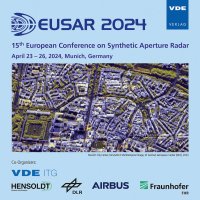A Photonics-Enhanced Bistatic High-Resolution Wide-Swath Synthetic Aperture Radar System Concept
Conference: EUSAR 2024 - 15th European Conference on Synthetic Aperture Radar
04/23/2024 - 04/26/2024 at Munich, Germany
Proceedings: EUSAR 2024
Pages: 6Language: englishTyp: PDF
Authors:
Ydreborg, Josef; Huber, Sigurd; Krieger, Gerhard
Abstract:
This paper presents a novel concept for implementing a gapless high-resolution wide-swath (HRWS) bistatic synthetic aperture radar (SAR) system using photonics in conjunction with the MirrorSAR concept. MirrorSAR is a bi- or multistatic SAR concept where the platforms are separated in transmit and receive. The simplified receive satellites, acting as space transponders for the echo signal, have highly reduced weight, size and power requirements leading to lower costs. This MirrorSAR setup can be used for gapless HRWS imaging when illuminating the swath by a wide-angle high dutycycle chirp and a high pulse-repetition frequency while the receiving platform generates multiple beams to collect the echos. Here, photonics can replace many system functions, including the optical beamforming networks (OBFN) allowing for the generation of multiple wideband beams without a significant impact on the receive platform computation and memory requirements. The OBFN outputs are multiplexed on the same channel using wavelength-division multiplexing and transferred back to the transmit platform via a free-space optics (FSO) link, where the beams are demultiplexed and coherently downconverted and digitised. An example architecture of such a system with the spectrum at selected points is presented assuming a phase shifter Blass matrix based OBFN in conjunction with a phased-array-fed reflector. Aside from additional discussion on optical frequency comb generation, beamforming network options and the FSO link, it is also shown how the concept can be straightforwardly expanded into a multistatic SAR constellation. Finally, an outlook is provided on further simulations and performance calculations required to evaluate the concept.


